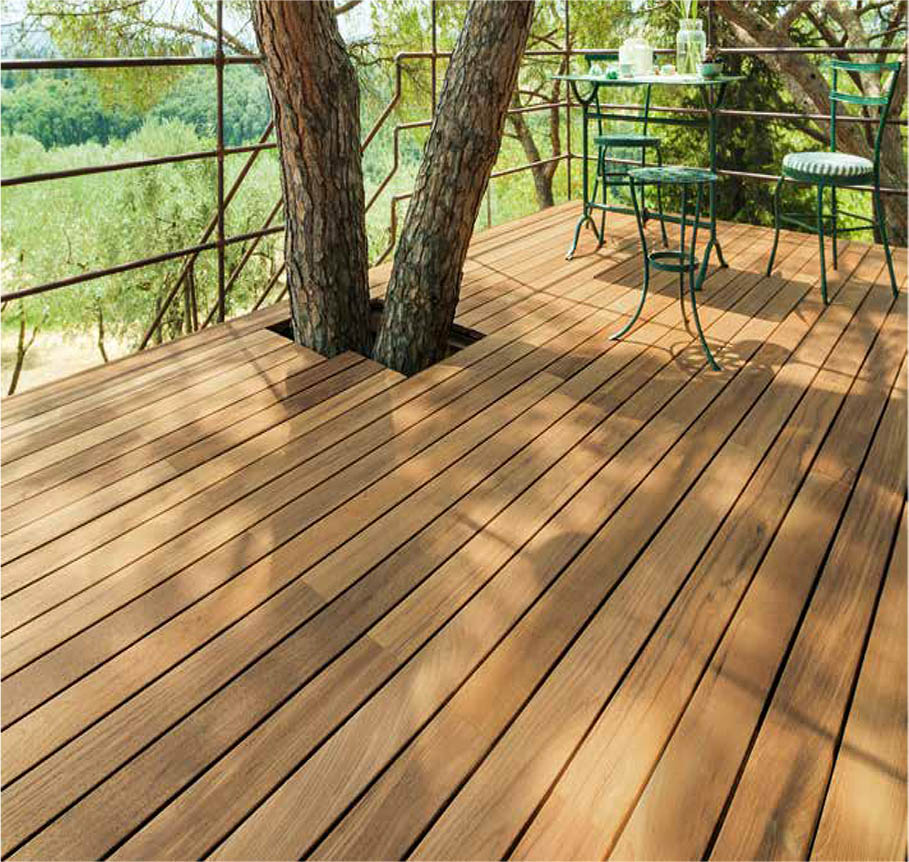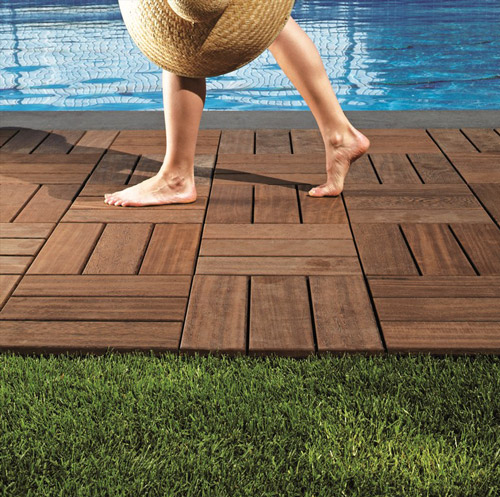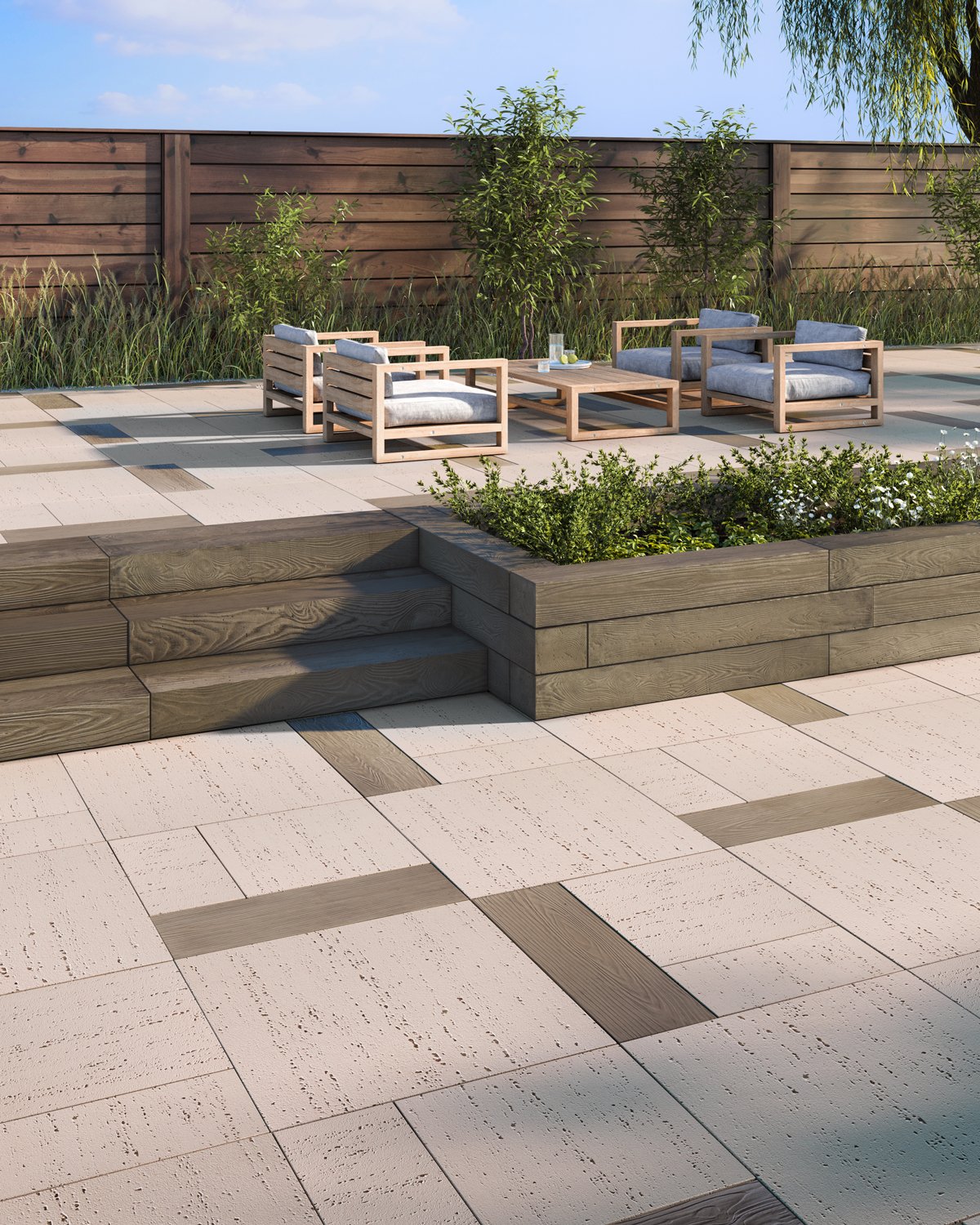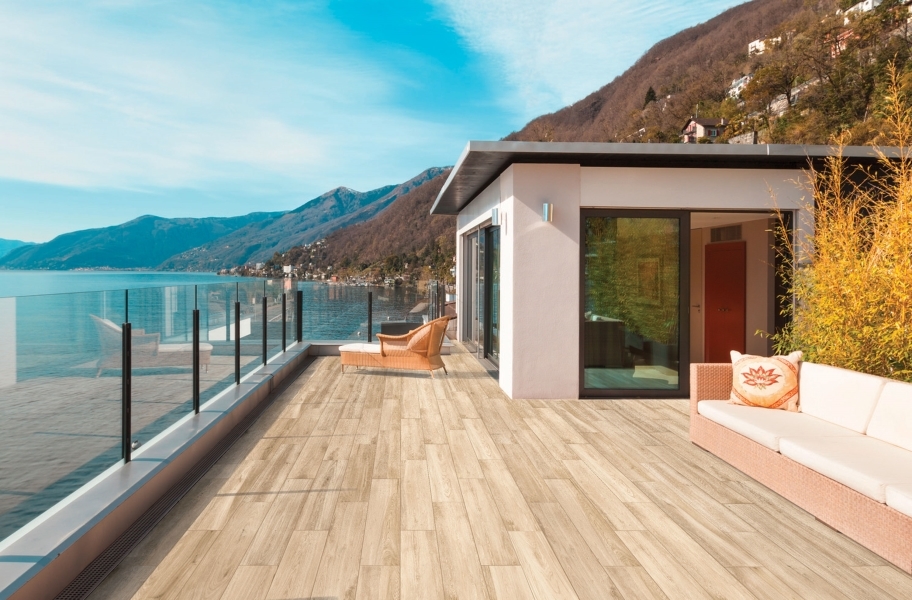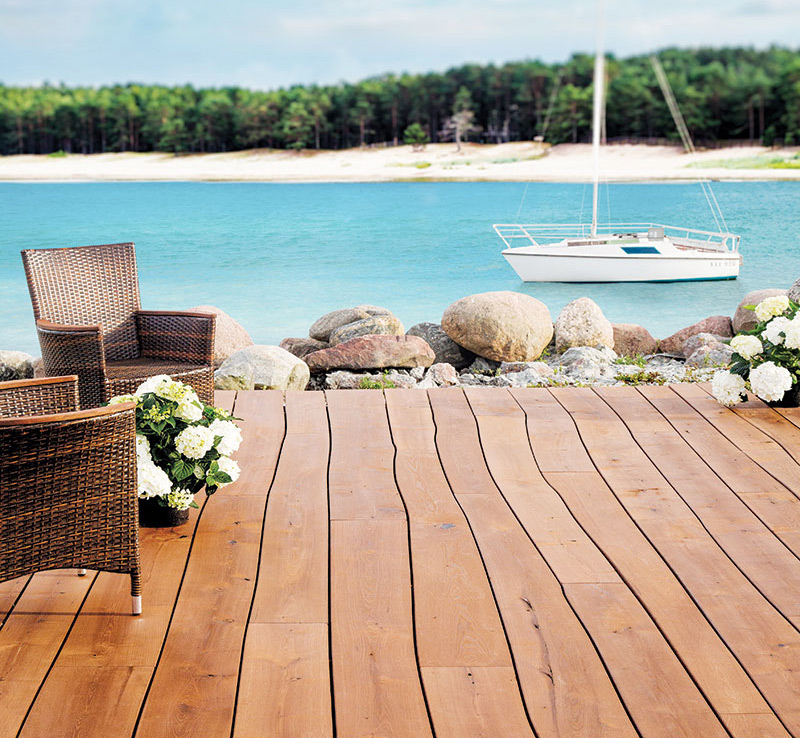The Benefits of Wood Flooring for Outdoor Spaces
Wood flooring isn’t just for indoor use; it’s also a fantastic option for enhancing outdoor spaces. From patios to decks, wood flooring can transform your outdoor area, adding warmth, charm, and functionality. Let’s explore the numerous benefits of using wood flooring outdoors and how it can elevate the aesthetics and functionality of your outdoor living space.
-
Natural Aesthetic: One of the primary benefits of wood flooring for outdoor spaces is its natural aesthetic appeal. Wood brings warmth and beauty to outdoor areas that other materials simply can’t match. Whether you prefer the rustic charm of weathered cedar or the timeless elegance of teak, wood flooring adds character and personality to your outdoor space, creating a welcoming atmosphere for entertaining or relaxation.
-
Versatility: Wood flooring offers a high level of versatility, allowing you to customize your outdoor space to suit your unique style and preferences. With a wide range of wood species, colors, and finishes to choose from, you can create a look that complements your home’s architecture and landscape design. Whether you’re aiming for a traditional, rustic vibe or a sleek, modern aesthetic, wood flooring can help you achieve your desired look with ease.
-
Durability and Longevity: Contrary to common belief, wood flooring can be highly durable and long-lasting when properly installed and maintained outdoors. Many wood species are naturally resistant to rot, decay, and insect damage, making them well-suited for outdoor use. Additionally, treated and sealed wood flooring can withstand exposure to harsh weather conditions, including sunlight, rain, and snow, ensuring that your outdoor flooring remains beautiful and functional for years to come.
-
Comfort and Safety: Wood flooring provides a comfortable and safe surface for outdoor activities, such as dining, lounging, and playing. Unlike hard surfaces like concrete or tile, wood flooring has a slight give underfoot, reducing fatigue and strain during prolonged use. Additionally, wood flooring tends to be less slippery when wet compared to other materials, reducing the risk of slips and falls, especially around pools and water features.
-
Ease of Maintenance: While outdoor wood flooring does require some maintenance to keep it looking its best, it’s relatively easy to care for compared to other materials. Regular sweeping or vacuuming to remove debris, along with occasional washing with mild soap and water, is usually all that’s needed to keep wood flooring clean and well-maintained. Additionally, applying a protective sealant every few years can help prolong the life of your outdoor wood flooring and enhance its resilience to the elements.
-
Value Addition: Lastly, wood flooring can significantly increase the value of your property by enhancing its curb appeal and outdoor living potential. A well-designed and maintained outdoor space can be a major selling point for prospective buyers, boosting the marketability and resale value of your home. Investing in quality wood flooring for your outdoor areas is not only a wise decision for your enjoyment but also a smart financial investment in the long term.

Choosing the Right Wood Species for Outdoor Flooring
Choosing the right wood species for outdoor flooring is crucial for ensuring the longevity, aesthetics, and performance of your outdoor space. With so many options available, from traditional hardwoods like teak and cedar to exotic species like ipe and mahogany, it’s essential to consider several factors before making your selection. Below are the key factors to consider when choosing the right wood species for outdoor flooring.
Durability: One of the most important factors to consider when choosing outdoor wood flooring is durability. Since outdoor flooring is exposed to harsh weather conditions, including sunlight, rain, and fluctuating temperatures, it’s essential to select a wood species that can withstand these elements without deteriorating or losing its structural integrity. Hardwoods such as teak, ipe, and cedar are renowned for their natural durability and resistance to rot, decay, and insect damage, making them popular choices for outdoor use.
Resistance to Moisture: Outdoor wood flooring is also exposed to moisture from rain, snow, and humidity, which can cause warping, cupping, and decay if the wood is not properly treated and sealed. When choosing a wood species for outdoor flooring, opt for species that have a natural resistance to moisture or can be effectively treated to enhance their moisture resistance. Additionally, consider the installation location and exposure to water when selecting wood flooring to ensure long-term performance and durability.
Appearance and Aesthetic: The appearance and aesthetic of the wood species are also important considerations when choosing outdoor flooring. Different wood species have distinct grain patterns, colors, and textures, which can significantly impact the overall look and feel of your outdoor space. Consider the architectural style of your home, the surrounding landscape, and your personal preferences when selecting a wood species that complements your outdoor design aesthetic and enhances the visual appeal of your outdoor space.
Maintenance Requirements: Another factor to consider when choosing outdoor wood flooring is the maintenance requirements of the wood species. Some wood species require more frequent maintenance, such as regular sealing or staining, to maintain their appearance and performance, while others are more low-maintenance and require minimal upkeep. Consider your lifestyle, available time, and willingness to perform maintenance tasks when selecting a wood species for outdoor flooring to ensure that it remains beautiful and well-maintained for years to come.
Availability and Cost: Lastly, consider the availability and cost of the wood species when making your selection. Some exotic hardwood species may be more difficult to source and more expensive than domestic hardwoods, which can impact your budget and project timeline. Additionally, consider the environmental impact and sustainability of the wood species, opting for responsibly sourced and eco-friendly options whenever possible.
Installation Techniques for Outdoor Wood Flooring
Installing outdoor wood flooring requires careful planning and execution to ensure durability, longevity, and optimal performance. From preparing the subfloor to choosing the right installation method, there are several key techniques to consider when installing wood flooring outdoors. Let’s discuss the essential installation techniques for outdoor wood flooring that will help you achieve a beautiful and resilient outdoor space.
Subfloor Preparation: Proper subfloor preparation is essential for the success of outdoor wood flooring installation. Ensure that the subfloor is clean, dry, and level before installing the wood flooring. Remove any debris, dirt, or old flooring materials, and repair any cracks, unevenness, or damage in the subfloor. A level and stable subfloor provides a solid foundation for the wood flooring and help prevent issues such as warping, buckling, and unevenness.
Moisture Barrier: Install a moisture barrier between the subfloor and the wood flooring to prevent moisture from penetrating the wood and causing damage over time. A waterproof membrane or vapor barrier helps protect the wood flooring from moisture-related issues, such as rot, decay, and mold growth. Ensure that the moisture barrier is properly installed and sealed to create a watertight seal and maximize protection against moisture intrusion.
Proper Ventilation: Adequate ventilation is crucial for maintaining the integrity and longevity of outdoor wood flooring. Ensure proper air circulation and ventilation underneath the wood flooring to prevent moisture buildup and promote drying. Use spacers or supports to create a gap between the wood flooring and the subfloor, allowing air to flow freely and moisture to evaporate, reducing the risk of mold and mildew growth.
Choose the Right Fastening Method: Select the appropriate fastening method for installing outdoor wood flooring based on the wood species, installation location, and project requirements. Common fastening methods for outdoor wood flooring include nails, screws, and hidden fastening systems. Choose corrosion-resistant fasteners that are specifically designed for outdoor use to ensure durability and longevity. Follow the manufacturer’s recommendations and guidelines for the recommended fastening method and spacing to achieve optimal results.
Sealing and Finishing: Apply a protective sealant or finish to the wood flooring after installation to enhance its durability and resistance to moisture, UV exposure, and other environmental factors. Choose a high-quality outdoor wood sealant or finish that is specifically formulated for exterior use and provides long-lasting protection against the elements. Apply multiple coats of sealant or finish according to the manufacturer’s instructions, ensuring complete coverage and adequate protection for the wood flooring.
Expansion and Contraction: Outdoor wood flooring is subject to expansion and contraction due to changes in temperature, humidity, and moisture levels. Allow for proper expansion and contraction by leaving a small gap around the perimeter of the wood flooring and between individual boards. Use spacers or shims to maintain consistent spacing and allow the wood flooring to expand and contract freely without buckling or warping.
Maintenance Tips for Outdoor Wood Flooring
Maintaining outdoor wood flooring is essential for preserving its beauty, durability, and resilience against the elements. From regular cleaning to periodic sealing and refinishing, there are several maintenance tasks to perform to keep outdoor wood flooring looking its best year-round. Below are some essential maintenance tips for outdoor wood flooring that will help you preserve its beauty and resilience for years to come.
Regular Cleaning: Regular cleaning is essential for removing dirt, debris, and stains from outdoor wood flooring and preventing buildup that can lead to deterioration and damage over time. Sweep or vacuum the wood flooring regularly to remove surface dirt and debris, and use a mild soap and water solution to wash away stubborn stains and spills. Avoid using harsh chemicals or abrasive cleaners that can damage the wood or finish.
Pressure Washing: Periodic pressure washing can help deep clean outdoor wood flooring and remove embedded dirt, grime, and mold or mildew growth. Use a pressure washer with a low-pressure setting and a wide-angle nozzle to avoid damaging the wood or causing splintering. Keep the pressure washer nozzle at least 12 inches away from the wood surface and use a sweeping motion to clean evenly. Allow the wood flooring to dry completely before applying any sealant or finish.
Sealing and Refinishing: Outdoor wood flooring should be sealed and refinished periodically to protect it from moisture, UV exposure, and other environmental factors that can cause damage and deterioration. Apply a fresh coat of sealant or finish every 1-2 years, or as needed, to maintain optimal protection and enhance the wood’s natural beauty. Choose a high-quality outdoor wood sealant or finish that is specifically formulated for exterior use and provides long-lasting protection against the elements.
Preventative Maintenance: Preventative maintenance can help prolong the life of outdoor wood flooring and reduce the need for costly repairs or refinishing down the line. Place mats or rugs in high-traffic areas and near entrances to trap dirt and debris and prevent scratches and wear. Use furniture pads or coasters under outdoor furniture legs to prevent scratching and denting of the wood flooring. Trim nearby trees and vegetation to prevent leaves, branches, and sap from accumulating on the wood surface and causing damage.
Inspect for Damage: Regularly inspect outdoor wood flooring for signs of damage, including cracks, splinters, rot, and insect infestations. Address any issues promptly to prevent further damage and deterioration. Repair or replace damaged boards as needed, and treat any areas affected by mold or mildew growth with a mildewcide cleaner to prevent spreading. By staying vigilant and addressing issues early, you can prolong the life of your outdoor wood flooring and keep it looking its best for years to come.
Winter Care: In colder climates, take extra precautions to protect outdoor wood flooring from winter weather conditions, such as snow, ice, and freeze-thaw cycles. Clear snow and ice promptly to prevent moisture buildup and damage to the wood surface. Use salt-free ice melters or sand to create traction on icy surfaces without damaging the wood. Consider covering outdoor wood flooring with a waterproof tarp or protective covering during the winter months to minimize exposure to moisture and prolong its lifespan.
Environmental Considerations: Sustainable Practices in Outdoor Wood Flooring
Sustainability is an essential consideration when choosing outdoor wood flooring, as it helps protect natural resources, reduce environmental impact, and promote responsible stewardship of our planet’s forests. By opting for sustainable wood flooring products and practices, homeowners can enjoy the beauty and functionality of outdoor wood flooring while minimizing their ecological footprint. Here are some key environmental considerations and sustainable practices in outdoor wood flooring.
Responsible Sourcing: Choose outdoor wood flooring products that are sourced from responsibly managed forests and certified by reputable organizations, such as the Forest Stewardship Council (FSC) or the Sustainable Forestry Initiative (SFI). These certifications ensure that the wood used in the flooring comes from forests that are managed in an environmentally and socially responsible manner, promoting biodiversity, protecting wildlife habitats, and respecting the rights of indigenous communities and forest workers.
Reclaimed and Recycled Materials: Consider using reclaimed or recycled wood for outdoor flooring projects to reduce the demand for virgin timber and minimize waste. Reclaimed wood flooring is sourced from salvaged materials, such as old barns, warehouses, and buildings, and repurposed for new construction projects. Recycled wood flooring is made from post-consumer or post-industrial wood waste, such as pallets, crates, and demolition debris, that is processed and manufactured into new flooring products.
Alternative Materials: Explore alternative materials and sustainable alternatives to traditional wood flooring for outdoor applications, such as bamboo, cork, and composite decking. Bamboo is a fast-growing and renewable resource that offers durability and resilience comparable to hardwoods, making it an eco-friendly alternative for outdoor flooring. Cork is harvested from the bark of cork oak trees without harming the tree, making it a sustainable and renewable material for flooring. Composite decking is made from recycled wood fibers and plastic, offering the look of wood with the durability and low maintenance of synthetic materials.
Low-Impact Installation Practices: Choose installation practices and techniques that minimize environmental impact and promote sustainability. Use environmentally friendly adhesives, sealants, and finishes that are low in volatile organic compounds (VOCs) and free from harmful chemicals. Opt for installation methods that reduce waste and conserve resources, such as modular systems or interlocking tiles that can be easily assembled and disassembled without the need for adhesives or fasteners.
Energy Efficiency: Consider the energy efficiency of outdoor wood flooring products and practices, including the energy required for manufacturing, transportation, and installation. Choose locally sourced wood flooring products whenever possible to reduce carbon emissions associated with transportation and support local economies. Minimize energy consumption during installation by using efficient tools and equipment, such as electric saws and battery-powered drills, and implement sustainable construction practices, such as minimizing waste and recycling materials.
Long-Term Sustainability: Consider the long-term sustainability and environmental impact of outdoor wood flooring products and practices, including their lifespan, durability, and recyclability. Choose durable and long-lasting wood flooring products that require minimal maintenance and have a low environmental footprint over their lifecycle. Opt for products that can be easily recycled or repurposed at the end of their useful life to minimize waste and promote circularity in the materials economy.
Outdoor Wooden Flooring Considerations – Wood and Beyond Blog
Easy Pieces: Wood Flooring for Decks – Gardenista
Synthetic Composite Wood Floor for Outdoor Flooring
Turn your Patio into a Haven with these Wood Flooring Ideas
Yaheetech 27pcs Wooden Floor Tiles Patio Pavers Composite Decking
2024 Outdoor Flooring Trends: 10+ Ways to Upgrade Your Space
3rd Street Inn Deck Tiles – Patio Pavers – Teak Wood Outdoor Flooring – Interlocking Patio Tiles – 12″x12″ – Teak Finish – Straight Pattern Decking
How to clean and maintenance outdoor wooden floors – Flooring magazine
Panorama of brown solid wood flooring for outdoor floors texture
Related Posts:
